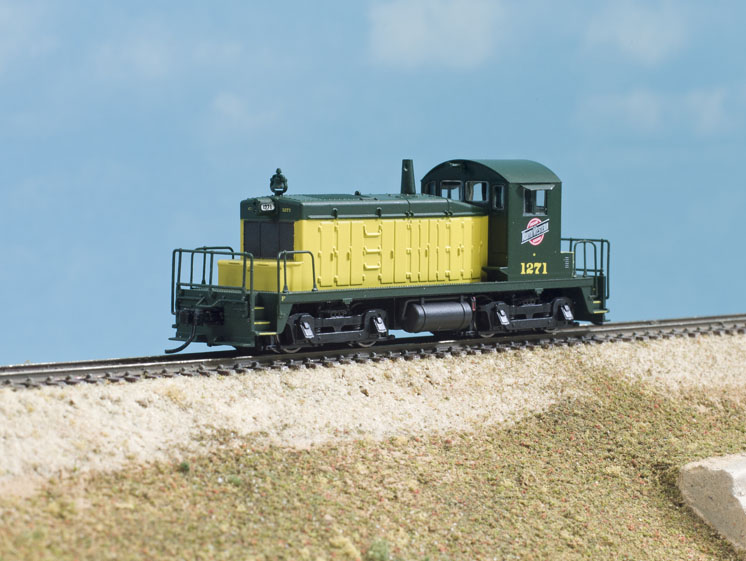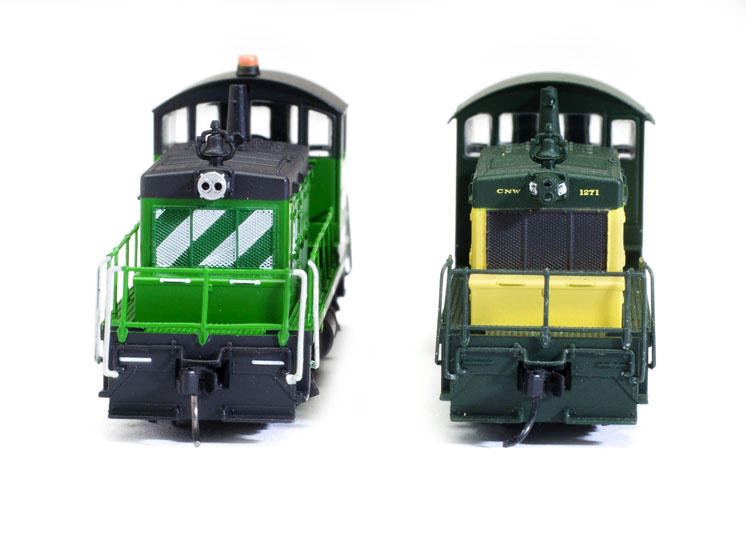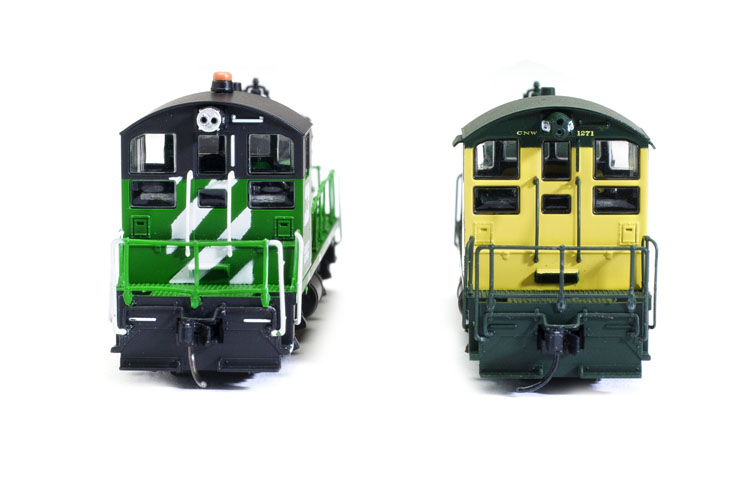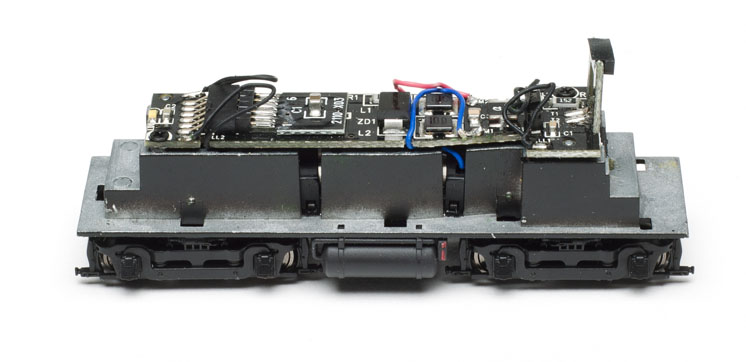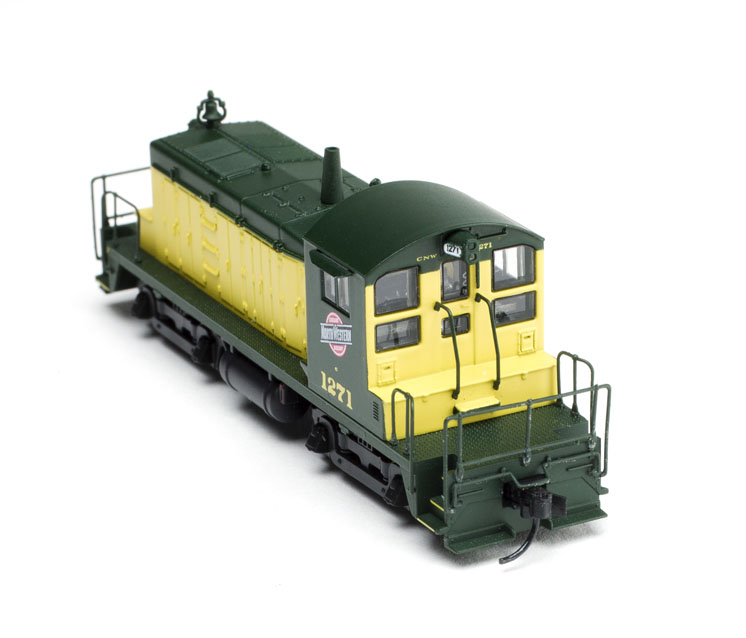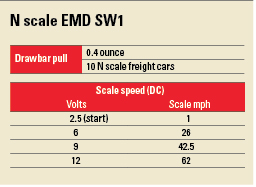End-cab yard switchers were among the earliest diesel-electric locomotive types used by railroads during the steam-to-diesel transition era. A pioneer yard goat, the General Motors Electro-Motive Division SW1, is the latest N scale locomotive from Arnold (Hornby America). The model features prototype-specific details and a smooth mechanism that’s easy to convert to Digital Command Control (DCC).
The prototype. Electro-Motive built 660 SW1 switchers from early 1939 to late 1953. Primarily built for yard service, the locomotive had a 6-cylinder 567 diesel prime mover rated at 600 hp.
Electro-Motive delivered a total of 21 SW1s to the Chicago & North Western Ry. between 1940 and 1953. Our review sample is decorated for no. 1271, which is one of the last 12 delivered in 1953. These CNW switchers were retired by the late 1970s.
The model. The N scale SW1 matches the dimensions of a prototype drawing in the November 1991 Model Railroader. The plastic hood and cab feature sharply molded detail that matches prototype photos. The handrails and stanchions are flexible plastic molded in dark green. Other separate parts include the bell, horn, and air reservoirs and piping mounted under the sill.
The plastic truck sideframes accurately depict Association of American Railroads (AAR) Type A switcher trucks, including solid-bearing journals and bolt detail on the drop-equalizer sideframes and well-defined clasp brakes. The scale 8-foot axle spacing and 40″ wheel diameter matches the prototype.
Our review sample is accurately detailed for a later production SW1, including a long hood that tapers into the cab and a tall tapered exhaust stack. The hoods on early production SW1s had notches in front of the cab, and the stacks were shorter.
Correct for the CNW prototype, the model’s cab has rectangular front windows. The model also depicts the prototype’s twin sealed-beam headlights, correctly arranged with the two lights stacked vertically.
For other road names, such as the Burlington Northern, Arnold produces a cab with the arched front windows of earlier production SW1s. To match the BN prototype, the model has twin sealed-beam headlights arranged side-to-side in a round housing as well as a (non-functioning) rooftop cab beacon.
For most of its career CNW no. 1271 had number boards that had white numerals on a black field. The model’s number boards have black numerals on a white field, which is seen in prototype photos of 1271 in the late 1970s.
The rest of the decoration matches prototype photos of no. 1271 at the end of its career in the 1970s, including the ball-and-bar herald on the cab sides.
Mechanism. The body shell is held in place by four clips. I used a toothpick to gently pry the side of the shell away from the chassis. I could then lift off the shell.
The chassis is die-cast metal. The motor features two brass flywheels and rests in the center of the chassis. Worm gears connect the motor to truck-mounted gearboxes. All four axles are powered and all eight wheels pick up electricity from the rails.
The printed-circuit (PC) board is mounted atop the weight. Surface-mount light-emitting diodes provide constant white light for the headlights.
The model can be easily converted to DCC by replacing the dummy plug in the 6-pin socket with a decoder. Several manufacturers make plug-in decoders that would fit this model, including Digitrax, NCE, and Train Control Systems. Adding sound would be a challenge, as there’s hardly any space for even the smallest speaker.
Performance. The SW1 started moving at 1 scale mph after I applied 2.5V to our direct-current test track. Although the mechanism was a bit noisy, the model accelerated smoothly to a top speed of 62 mph at 12V. The prototype was geared for a top speed of 50 mph, but would usually operate at much lower speed.
The N scale engine easily negotiated 10″ radius curves and no. 4 turnouts. Its .4 ounce drawbar pull is equivalent to 10 N scale freight cars on straight and level track. This pulling power is on par with other N scale switchers.
This reliably operating model should be able to handle most switching chores. The sharp detail and decoration of the Arnold SW1 would make it the star of an N scale freight yard.
Price: $129.99
Manufacturer
Hornby America Inc.
3900-C2 Industry Drive East
Fife, WA 98424
www.hornbyamerica.com
Era: 1950s to 1970s (as detailed)
Road names: (two road numbers each) Chicago & North Western, Amtrak, Boston & Maine, Burlington Northern, and Penn Central
Features
▪▪All-wheel drive and electrical pickup
▪▪6-pin DCC socket
▪▪Die-cast metal chassis
▪▪Directional light-emitting diode headlights
▪▪Five-pole can motor with dual brass flywheels
▪▪Plastic knuckle couplers mounted at correct height
▪▪Weight: 1.5 ounces





